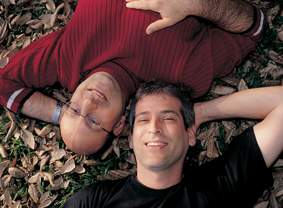Are you a journalist? Please sign up here for our press releases
Subscribe to our monthly newsletter:

In a world of stable populations where each individual must struggle to survive, those with the "best" characteristics will be more likely to survive, and those desirable traits will be passed to their offspring.
- Ernst Mayr, The Growth of Biological Thought
Was Darwin right, back in 1859, when he proposed what is arguably the most famous, and the most controversial, theory in the history of biology? Natural selection, or "survival of the fittest," despite the overwhelming scientific evidence in its support, remains just a theory. Direct proof of natural selection has been lacking because it's been difficult to test fitness quantitatively in the lab – until now.
To address the ongoing natural selection debate, post-doctoral fellow Erez Dekel, working under the supervision of Prof. Uri Alon of the Weizmann Institute of Science's Molecular Cell Biology and Physics of Complex Systems Departments, devised a set of experiments to measure, for the first time, the fitness of a simple organism and ascertain whether it is really the fittest organisms that survive into the next generation.
They studied a simple one-celled organism (the bacterium Escherichia coli) and its production of lactose protein, an enzyme that allows the bacterium to utilize lactose, the sugar in milk. The scientists asked themselves: Why does the E. coli cell make a specific number of lactose proteins – 60,000 – as opposed to, say, 50,000 or 70,000? And is this number really the optimum; that is, does this amount somehow make a better contribution to the organism's survival than any other?
Indeed, their results, recently published in Nature, showed that, like the baby bear's porridge – neither too hot nor too cold, but just right – there is a "just right" amount of protein that a bacterium should produce for maximum gain. "It is all a matter of weighing up the costs and benefits," explains Alon. For a bacterium living in a given lactose environment, produce too much protein, and the cost of production and maintenance becomes a burden. Produce too little protein, and the bacterium cannot reap all the benefits of the available sugar. But with just the right amount of protein, the bacterium thrives and produces offspring with the optimal potential.
After measuring the cost of manufacturing the lactose protein and the benefits gained by utilizing the sugar, Dekel decided to take the experiment one step further. He wanted to find out whether the level of protein production can actually change over evolutionary time scales. But how to test whether natural selection is really at work or whether the changes that occur are due to chance?
He approached this problem by growing E. coli in seven separate test tubes, each containing different amounts of lactose. Every day he took a sample of bacteria out of each tube and placed it in a fresh tube containing the same amount of lactose as the previous one. A few months and more than 550 generations of E. coli later, the time had come to analyze the results. Dekel found that not only did each line of bacteria evolve and adapt by altering the amount of the protein produced, but those amounts corresponded to the optimum levels he had predicted in his previous experiment. These heritable changes were seen to take effect after only 200-300 generations.
Some biologists have suggested that the details of various biological systems are just historical accidents that get handed down from generation to generation like Great-Grandma's old furniture. In this scenario, asking why a cell produces a specific number of proteins would be like wondering what advantage there is to having carved legs on the table - they just are. But the team's findings show that, just as you can replace the legs on Great-Grandma's table with ones that are easier to dust, simple organisms can rapidly and accurately evolve to reach an optimal state. "We have witnessed the survival of the fittest in a test tube," says Alon. Is this proof of natural selection "fit" enough to survive the scrutiny of the next generation of skeptics? Time, and further experiments, will tell.
Prof. Uri Alon's research is supported by the Nella and Leon Benoziyo Center for Neurological Diseases; the Clore Center for Biological Physics; the Yad Abraham Research Center for Cancer Diagnostics and Therapy; the Leon and Gina Fromer Philanthropic Fund; the Kahn Family Foundation for Humanitarian Support; the Minerva Stiftung Gesellschaft fuer die Forschung m.b.H.; the James and Ilene Nathan Charitable Directed Fund; the Harry M. Ringel Memorial Foundation; the estate of Ernst and Anni Deutsch, Liechtenstein; and Mr. and Mrs. Mordechai Segal, Israel.
In a series of related, ongoing projects, Alon uses computer simulations to study the theoretical basis of the mechanisms underlying evolution. His most recent work, done in collaboration with Ph.D. student Nadav Kashtan, offers an explanation as to why many biological systems seem to have evolved to be modular – made up of many separate building blocks that are able to perform independently.
For example, a cheetah and a giraffe both possess four limbs, which can be thought of as four modules. Evolution can make small adjustments to this template to meet the different needs of each animal. For the cheetah, the modules can be tweaked to result in limbs that run fast, whereas for the giraffe, the same basic modules can be tweaked slightly differently to create longer limbs. The study hints that modular systems may spontaneously arise with environmental changes that are themselves modular, thus allowing organisms to adapt more rapidly. Modular design might also help to speed up the process of evolution, allowing nature to tinker with the parts rather than redesigning the whole animal.